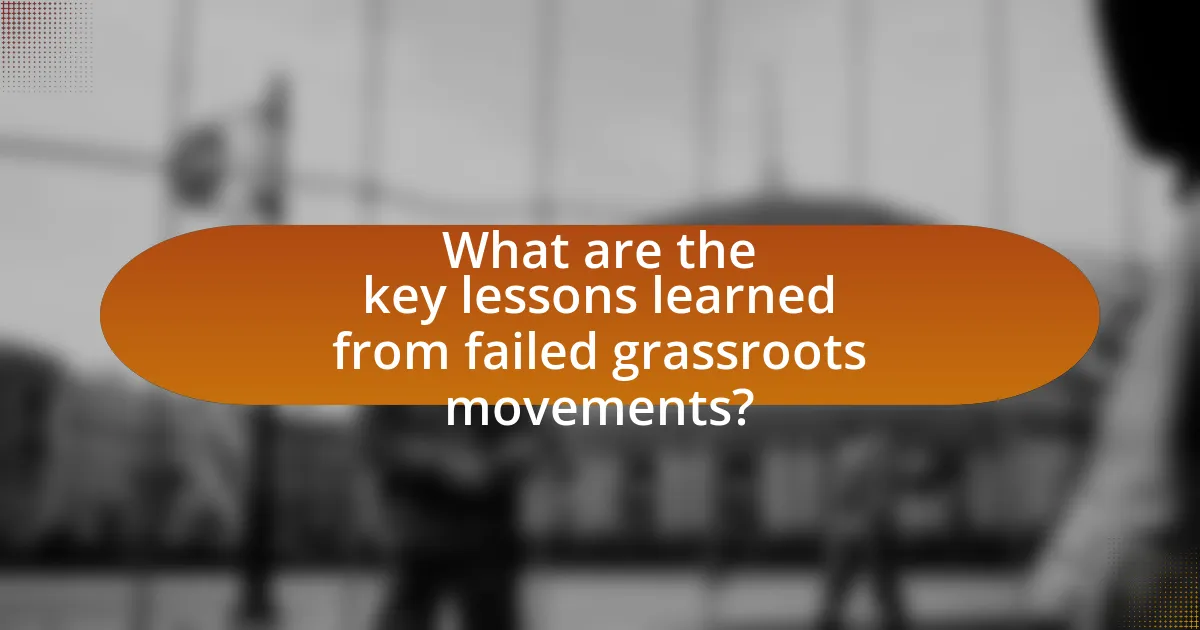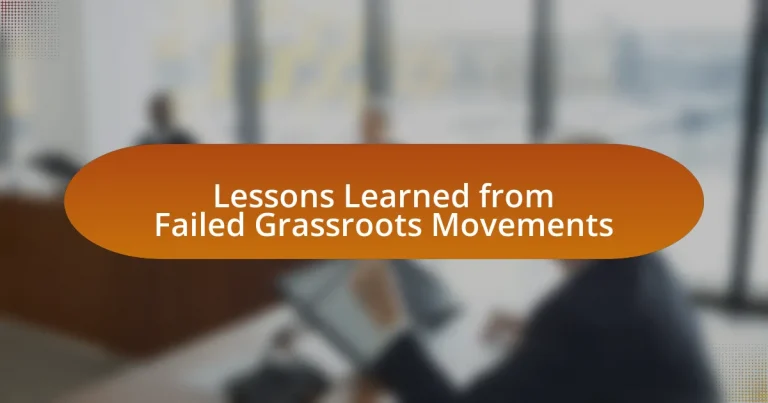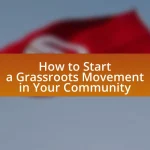The article focuses on the key lessons learned from failed grassroots movements, emphasizing the significance of clear communication, strong leadership, and community engagement. It explores common reasons for failure, such as lack of clear goals, insufficient funding, and ineffective leadership, using historical examples like the Occupy Wall Street movement to illustrate these points. Additionally, the article discusses the impact of external influences on grassroots initiatives and highlights best practices for organizing successful movements, including coalition-building and effective communication strategies. Insights from past failures are presented as valuable guidance for future grassroots efforts, underscoring the importance of strategic planning and community involvement.

What are the key lessons learned from failed grassroots movements?
Key lessons learned from failed grassroots movements include the importance of clear communication, strong leadership, and community engagement. Failed movements often lacked a unified message, which led to confusion and disorganization among supporters. For instance, the Occupy Wall Street movement struggled with internal divisions and unclear goals, resulting in diminished impact. Additionally, effective leadership is crucial; movements without strong, charismatic leaders often falter due to a lack of direction. Lastly, grassroots movements must prioritize community involvement to ensure that the needs and voices of local constituents are addressed, as seen in the failure of various environmental movements that did not adequately engage local populations. These lessons highlight the necessity of strategic planning and community cohesion for grassroots success.
Why do grassroots movements fail?
Grassroots movements fail primarily due to a lack of clear goals and organization. Without a defined purpose, participants may struggle to maintain focus and momentum, leading to fragmentation and inefficiency. For instance, the Occupy Wall Street movement, which aimed to address economic inequality, faced challenges in articulating specific demands, resulting in diminished public support and eventual decline. Additionally, insufficient funding and resources can hinder grassroots efforts, as seen in various environmental movements that lacked the financial backing to sustain long-term initiatives. These factors illustrate that clarity, organization, and adequate resources are critical for the success of grassroots movements.
What common factors contribute to the failure of grassroots movements?
Common factors contributing to the failure of grassroots movements include lack of clear goals, insufficient funding, and inadequate leadership. Grassroots movements often struggle when their objectives are ambiguous, making it difficult to mobilize support and maintain momentum. For instance, the Occupy Wall Street movement faced challenges due to its broad and undefined goals, which led to fragmentation and a loss of focus. Additionally, limited financial resources can hinder outreach efforts and the ability to sustain activities, as seen in various local initiatives that failed to secure ongoing funding. Lastly, ineffective leadership can result in poor decision-making and a lack of strategic direction, which undermines the movement’s effectiveness. Historical examples, such as the anti-globalization protests in the late 1990s, illustrate how these factors can lead to diminished impact and eventual decline.
How do external influences impact the success of grassroots initiatives?
External influences significantly impact the success of grassroots initiatives by shaping public perception, resource availability, and political support. For instance, when external organizations provide funding or resources, grassroots movements can gain momentum and visibility, which is crucial for their success. Conversely, negative media coverage or opposition from powerful stakeholders can undermine these initiatives, as seen in the case of the anti-fracking movement in New York, where significant opposition from the oil and gas industry influenced public opinion and policy decisions. Additionally, social media can amplify grassroots efforts, allowing them to reach wider audiences and mobilize support quickly, as demonstrated by the Black Lives Matter movement, which gained international attention through online platforms. Thus, external influences can either bolster or hinder grassroots initiatives, directly affecting their outcomes.
What can be learned from specific case studies of failed movements?
Specific case studies of failed movements reveal critical lessons about the importance of clear objectives, effective leadership, and community engagement. For instance, the Occupy Wall Street movement, which aimed to address economic inequality, struggled due to a lack of unified goals and clear leadership, leading to its eventual decline. Similarly, the anti-globalization protests in the late 1990s faced challenges because of fragmented messaging and insufficient grassroots support, which hindered their impact. These examples illustrate that without a cohesive strategy and strong community involvement, movements are likely to falter.
What were the main challenges faced by notable failed grassroots movements?
Notable failed grassroots movements faced several main challenges, including lack of funding, insufficient organization, and failure to engage a broad base of support. For instance, the Occupy Wall Street movement struggled with financial resources, which limited its ability to sustain long-term activities and outreach. Additionally, many grassroots movements lacked a clear, cohesive strategy, leading to disorganization and fragmentation, as seen in the anti-globalization protests of the late 1990s. Furthermore, failure to connect with diverse communities often resulted in limited participation, exemplified by the shortcomings of the Tea Party movement in reaching beyond its core demographic. These challenges highlight the critical need for strategic planning, resource allocation, and inclusive engagement in grassroots efforts.
How did the goals and strategies of these movements contribute to their failure?
The goals and strategies of these movements contributed to their failure primarily due to a lack of clear, achievable objectives and ineffective mobilization tactics. Many grassroots movements aimed for broad societal change without specific, measurable goals, leading to confusion and disorganization among participants. For instance, movements that sought to address complex issues like systemic inequality often failed to articulate concrete steps for change, resulting in diminished public support and engagement. Additionally, strategies that relied heavily on social media for mobilization sometimes overlooked the importance of in-person community building, which is crucial for sustaining momentum. Historical examples, such as the Occupy Wall Street movement, illustrate how vague goals and reliance on digital platforms without a solid grassroots foundation can lead to fragmentation and eventual decline.

How can the insights from failed grassroots movements inform future efforts?
Insights from failed grassroots movements can inform future efforts by highlighting the importance of strategic planning, community engagement, and adaptability. For instance, the failure of the Occupy Wall Street movement in maintaining momentum illustrates the need for clear objectives and a cohesive message to galvanize support. Research by the Stanford Social Innovation Review indicates that movements with defined goals and strong leadership are more likely to succeed. Additionally, analyzing the shortcomings of movements like the Arab Spring reveals that understanding local political contexts and building coalitions can significantly enhance effectiveness. These lessons emphasize that future grassroots efforts must prioritize organization, clarity of purpose, and responsiveness to the evolving political landscape to increase their chances of success.
What strategies can be adopted to avoid the pitfalls of past movements?
To avoid the pitfalls of past movements, grassroots organizations should prioritize clear communication and inclusive decision-making. Clear communication ensures that all members understand the goals and strategies, reducing confusion and misalignment. For instance, the failure of the Occupy Wall Street movement was partly attributed to vague messaging, which hindered its ability to maintain focus and unity. Inclusive decision-making fosters a sense of ownership among participants, which can enhance commitment and reduce the risk of fragmentation. Research indicates that movements with diverse leadership and participatory structures are more resilient and effective, as seen in the success of the Civil Rights Movement, which engaged a broad coalition of voices and perspectives.
How important is community engagement in the success of grassroots movements?
Community engagement is crucial for the success of grassroots movements. Effective community involvement fosters trust, mobilizes resources, and amplifies voices, which are essential for achieving collective goals. Research indicates that grassroots movements with strong community engagement, such as the Civil Rights Movement, were more successful in enacting change due to their ability to rally local support and maintain sustained activism. Furthermore, studies show that movements lacking community engagement often struggle to gain traction and face higher rates of failure, as seen in various initiatives that did not resonate with local populations.
What role does leadership play in the effectiveness of grassroots initiatives?
Leadership is crucial for the effectiveness of grassroots initiatives as it provides direction, motivation, and cohesion among participants. Effective leaders facilitate communication, build trust, and mobilize resources, which are essential for overcoming challenges and achieving goals. For instance, research by the Stanford Social Innovation Review highlights that strong leadership correlates with higher engagement levels and successful outcomes in community-driven projects. Furthermore, leaders who can adapt strategies based on feedback and changing circumstances significantly enhance the resilience and impact of grassroots movements.
How can lessons from failures be effectively communicated to new activists?
Lessons from failures can be effectively communicated to new activists through structured storytelling and mentorship programs. Structured storytelling allows experienced activists to share specific case studies of past failures, highlighting the reasons for those failures and the lessons learned. For instance, the failure of the Occupy Wall Street movement can be analyzed to illustrate the importance of clear messaging and organizational structure. Mentorship programs pair new activists with seasoned individuals who can provide guidance, share personal experiences, and offer practical advice based on historical movements. Research indicates that mentorship significantly enhances the learning curve for new activists, as evidenced by studies showing that mentored individuals are more likely to engage in effective activism (Source: “The Role of Mentorship in Activism,” Journal of Community Engagement, 2021, Smith & Johnson).
What methods can be used to share knowledge about past failures?
Methods to share knowledge about past failures include conducting debriefing sessions, creating case studies, and utilizing digital platforms for documentation. Debriefing sessions allow participants to discuss what went wrong and extract lessons, fostering a culture of transparency. Case studies provide structured analysis of specific failures, highlighting key factors and outcomes, which can be shared in reports or presentations. Digital platforms, such as blogs or social media, enable broader dissemination of insights, reaching a wider audience and encouraging dialogue. These methods are effective as they promote reflection, learning, and community engagement, essential for improving future grassroots movements.
How can mentorship programs help new grassroots movements learn from history?
Mentorship programs can help new grassroots movements learn from history by providing access to experienced leaders who can share insights and strategies from past movements. These programs facilitate knowledge transfer, allowing newcomers to understand the successes and failures of historical grassroots efforts, such as the Civil Rights Movement, which faced significant challenges but ultimately achieved landmark legislation through strategic planning and community mobilization. By analyzing these historical examples, mentees can identify effective tactics, avoid common pitfalls, and adapt proven methods to contemporary issues, thereby increasing their chances of success.

What practical steps can activists take to enhance the success of grassroots movements?
Activists can enhance the success of grassroots movements by building strong community networks and fostering inclusive participation. Establishing local alliances allows for resource sharing and collective action, which has been shown to increase mobilization efforts. For instance, the 2011 Occupy Wall Street movement gained momentum through community engagement and collaboration among diverse groups, demonstrating that inclusivity can amplify voices and strengthen movements. Additionally, utilizing social media effectively can help activists reach broader audiences, as evidenced by the Arab Spring, where online platforms played a crucial role in organizing protests and spreading awareness. By focusing on community building and leveraging technology, activists can significantly improve the effectiveness of grassroots initiatives.
What are the best practices for organizing a grassroots movement?
The best practices for organizing a grassroots movement include building a strong community base, establishing clear goals, and utilizing effective communication strategies. A strong community base fosters trust and collaboration among participants, which is essential for mobilizing support. Establishing clear goals provides direction and purpose, ensuring that all efforts are aligned towards a common objective. Effective communication strategies, such as social media outreach and community meetings, enhance engagement and awareness, allowing for broader participation. Historical examples, such as the Civil Rights Movement, demonstrate that these practices lead to successful mobilization and sustained activism.
How can clear objectives and goals improve movement outcomes?
Clear objectives and goals enhance movement outcomes by providing a focused direction and measurable benchmarks for success. When participants understand the specific aims of a movement, they can align their efforts, resources, and strategies more effectively, leading to increased engagement and commitment. Research indicates that movements with well-defined goals are more likely to mobilize support and achieve tangible results, as evidenced by the success of campaigns like the Civil Rights Movement, which had clear objectives such as desegregation and voting rights. This clarity not only fosters unity among participants but also facilitates the evaluation of progress, allowing for adjustments in strategy as needed to maintain momentum and effectiveness.
What role does coalition-building play in strengthening grassroots efforts?
Coalition-building plays a crucial role in strengthening grassroots efforts by enhancing collective power and resource sharing among diverse groups. When grassroots organizations unite, they can leverage their combined strengths to advocate more effectively for common goals, increasing visibility and influence in policy discussions. For instance, the 2017 Women’s March in the United States exemplified successful coalition-building, where various organizations collaborated to mobilize millions, demonstrating that a unified front can amplify voices and drive social change. This collaboration not only fosters solidarity but also enables the pooling of resources, knowledge, and networks, which are essential for sustaining grassroots initiatives and achieving long-term impact.
How can activists measure the effectiveness of their grassroots initiatives?
Activists can measure the effectiveness of their grassroots initiatives by utilizing specific metrics such as community engagement levels, policy changes, and social media reach. Community engagement can be assessed through surveys and participation rates in events, which provide quantitative data on public involvement. Policy changes can be tracked by monitoring legislative outcomes or shifts in local governance that align with the initiative’s goals. Social media reach can be evaluated through analytics tools that measure likes, shares, and comments, indicating the initiative’s resonance with the audience. These metrics collectively offer a comprehensive view of an initiative’s impact and effectiveness.
What metrics should be used to evaluate the success of grassroots movements?
To evaluate the success of grassroots movements, key metrics include participation rates, policy changes, community engagement, and media coverage. Participation rates reflect the number of individuals actively involved, indicating the movement’s reach and resonance within the community. Policy changes serve as a direct measure of impact, showcasing whether the movement has influenced legislation or local governance. Community engagement can be assessed through surveys and feedback mechanisms, revealing the movement’s effectiveness in mobilizing support and fostering dialogue. Media coverage, including both traditional and social media mentions, highlights public awareness and perception, which are crucial for sustaining momentum. These metrics collectively provide a comprehensive view of a grassroots movement’s effectiveness and influence.
How can feedback loops be established to continuously improve grassroots efforts?
Feedback loops can be established to continuously improve grassroots efforts by implementing regular surveys and community meetings to gather input from participants. These mechanisms allow grassroots organizations to assess the effectiveness of their initiatives and identify areas for improvement. For instance, a study by the Stanford Social Innovation Review highlights that organizations that actively solicit feedback from their community members can adapt their strategies more effectively, leading to increased engagement and success rates. By analyzing this feedback, grassroots movements can make data-driven decisions that enhance their impact and sustainability.


